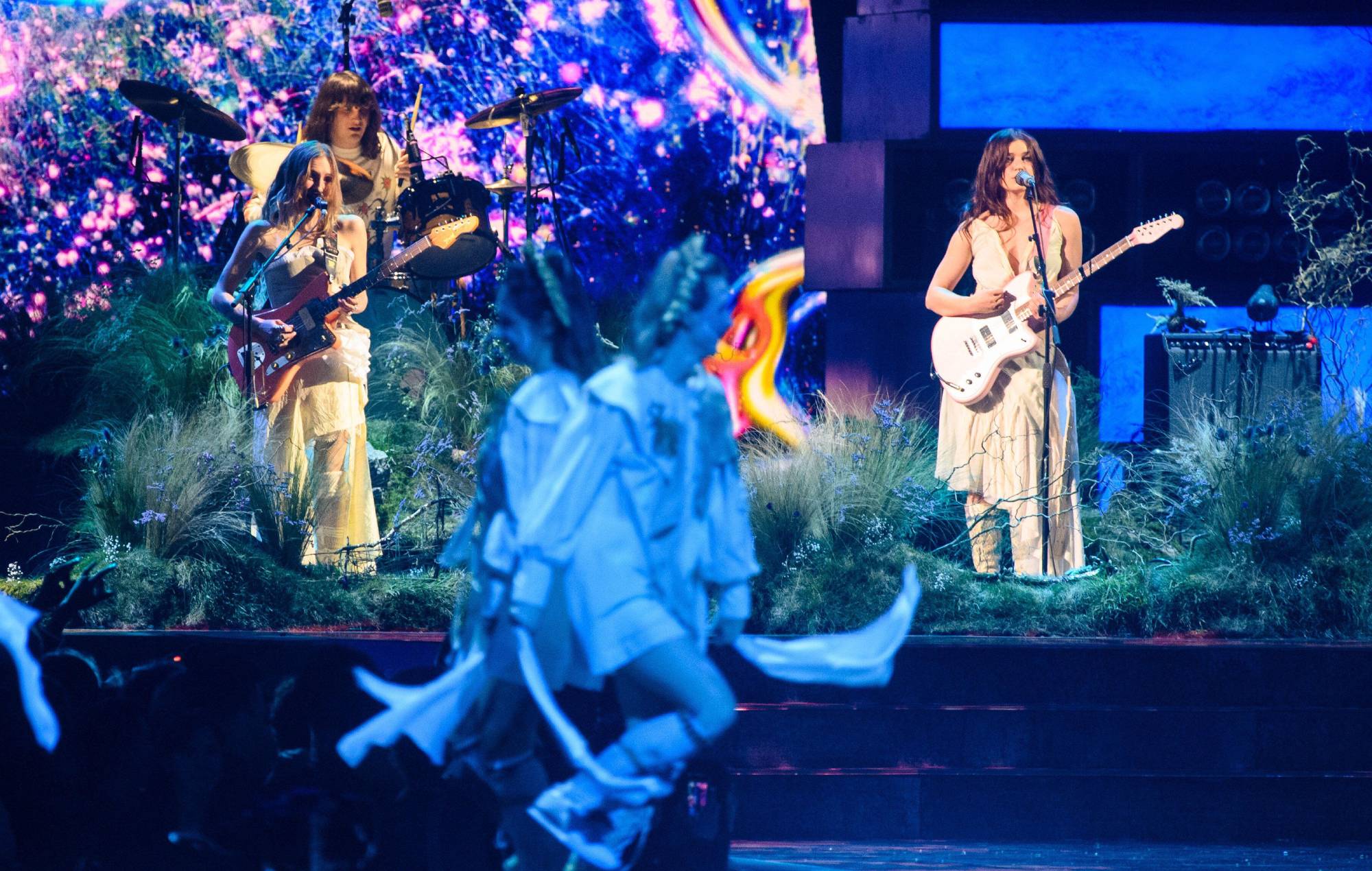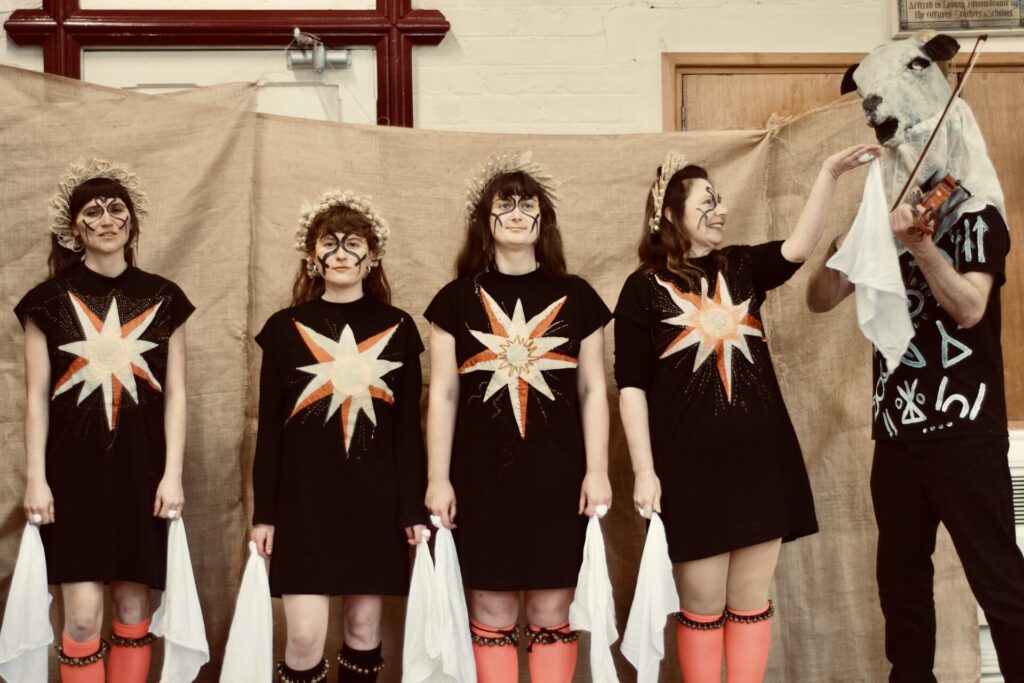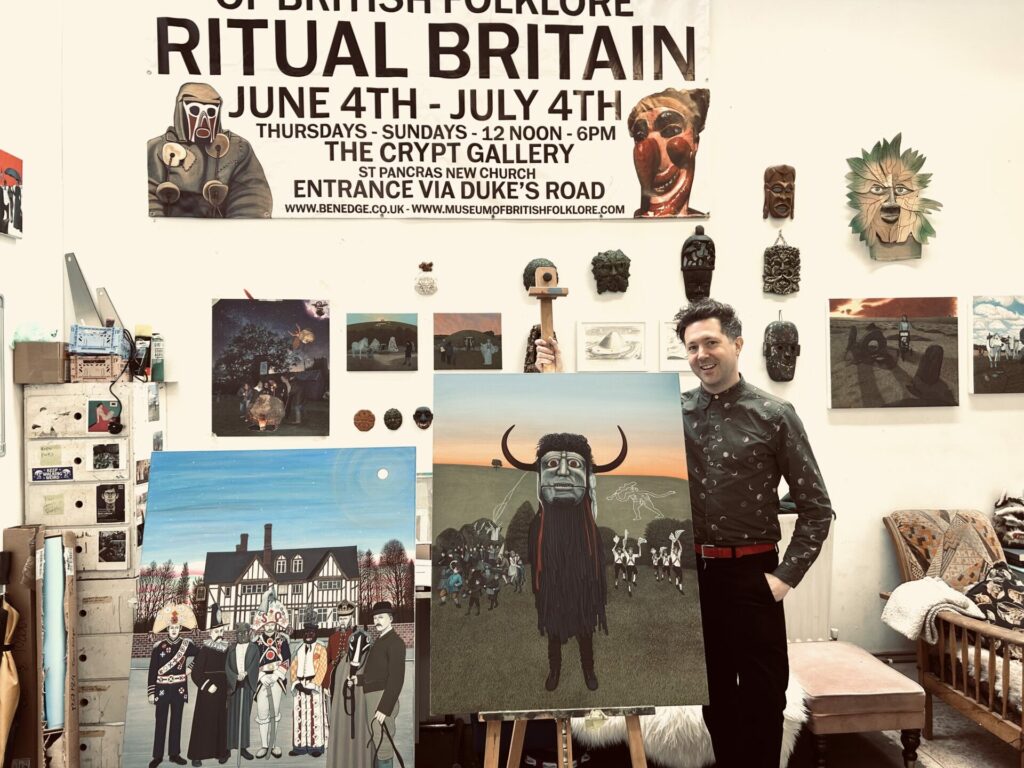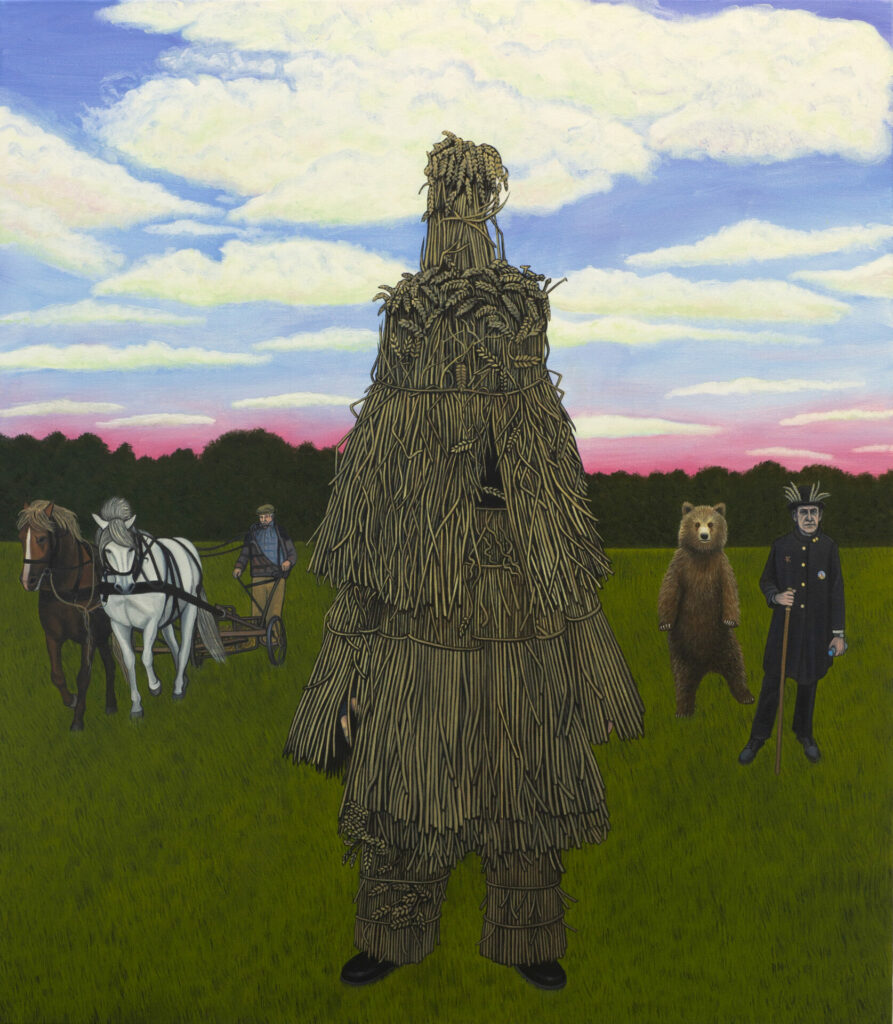Less pale male and stale – how British folk is getting a remix
Think that folk music is just old men warbling in a bar? Then think again. From Morris dancing at the BRIT Awards to queer sea shanties and punk zines about stone circles, ye olde England is getting cool-as-folk with a new generation.
By Zoey Goto

In case you missed it, 2023 looks set to be the year that British folk finally has a renaissance. Following decades as a slightly embarrassing cultural relic, all it took was 12 Morris dancing women gracing the BRIT Awards stage to flick the switch from bygone to boss.
Against a soundtrack of electric guitar licks, the all-female dance troupe Boss Morris joined indie rockers Wet Leg on stage in February, dressed like Pagan goddesses stumbling home from a hardcore rave. For three-and-a-half heart-pumping minutes, the “prog-Morris” collective, plus a couple of random mythical woodland beasts, hijacked our screens with a showcase of traditional English dancing, last notably seen at village fates in the 1980s.
Following a stunned silence, the internet lit up with bewildered viewers asking why, oh why, had a dance craze dating back to Henry VIII’s era shared airtime with the likes of Lizzo and Sam Smith. I headed to the quaint market town of Stroud to find out.
Wearing flashes of electric blue lipstick and socks fringed with tinkling bells, I’m greeted by the Boss Morris collective in their local church hall. Post show, the level of curiosity also came as a surprise to Boss Morris, dancer Rhia Davenport laughs.

“When the BRIT Awards video was posted on YouTube, it received hundreds of comments and we had a flurry of interest from people wanting to find out more” Davenport says of the performance, which has already received over half a million views in the past few months. “Afterwards, the artist Jeremy Deller said that it felt like a culturally significant moment for Britain and that he’d made musician Jarvis Cocker watch it” adds Alex Merry, one of the crew’s founding members.
Boss Morris had already laid the groundwork for this overnight surge of interest, having built up an engaged presence on the socials. “Instagram is definitely responsible for part of our success. We’re one of the first Morris sides to use fun, bright images to create a feed that’s visually appealing to the eye” Merry notes.
In a world where folkies are now more likely to connect virtually than through the smoky haze of a working men’s club, Boss Morris rank top of hashtag searches for Morris dancing, helped by the fact that a recent TikTok video of them frolicking went viral with a quarter of a million views.
As a tech-savvy, female-only group, they’ve carved out an offbeat niche, sharing the alt-Morris space with a handful of other hanky-waving, future-facing dance groups that includes Acid Morris, a tribe who bust antique moves to the thumping pulse of techno.
The pandemic also played a part in folklore’s revival, dancer Lily Cheetham is quick to highlight. “Covid kickstarted things, with people wanting to leave cities to connect to the land and the yearly calendar. When you’re not distracted by everyday life, it makes space for these things” she says, placing a golden crown of corn upon her head like Gaia, the Wicca Earth Mother.
Still, for all this progressive talk, an undeniable association with English nationalism lingers – or worse yet, a perceived thorny handshake with the dark underbelly of far-right ideology. It’s a misconception and actually the opposite is true, says the artist Ben Edge when I call in at his North London studio.

“I think young people are engaging with folklore because it’s a way of opposing nationalism in an organic, grassroots way. Really, what we’re talking about is a celebration of regional culture. It’s an antidote to the London-centricity of the country and to capitalism” he says, surrounded by his intricate paintings of blazing barrel runs and people dressed head-to-toe in straw or spiky burrs.
Edge has been in the trenches of the folk scene, having travelled the length and breadth of the British Isles documenting its seasonal customs for a series of paintings and a forthcoming film entitled Frontline Folklore. His interest was first sparked following a chance encounter with a Druid ceremony, awakening something within that felt ancient and lost, says the artist, whose exhibition in a crypt last year managed to attract a cool 20,000 visitors during its month-long run.
“In the early days, people would laugh and ask me why I was hanging around with Morris dancers?! But I soon found a community online who were into similar things, visiting stone circles and reading Weird Walk”, a stapled-together zine about sacred sites and pathways, that shares a lo-fi aesthetic with the 1970s cult punk publication Sniffin’ Glue.
I wonder out loud if part of folk’s current appeal is that it predates the British Empire, a chapter of history increasingly looked upon with shame? “I’m not sure if it’s about sidestepping history, but there’s certainly a connection between the people who started these folk traditions and the victims of the British Empire” Edge says, as behind him a painting of a latex covered creature, part of a May Day celebration in Padstow, looks on menacingly.

In the 18th and 19th centuries, the English government and aristocracy declared sweeps of common land out of bounds for the people. Nowadays, this legacy is still felt in a country where less than 1 percent of the population – including royals, aristocrats and wealthy investors – own about half of England’s land.
“As with the victims of the Empire, indigenous culture was taken away from the peasants when they were pushed off their land, so there’s a need to reconnect. Folk has always been the culture of the people, which has nothing to do the upper classes and their stately homes. Coming at it from that angle, folk culture can create a more inclusive Britain today”, says Edge. Last year he was involved with a Right to Roam trespass, where, dressed in a natty suit, he joined a colourful parade through Lord Benyon’s estate.
Folk is also crossing over into the indie music scene, Edge adds. “The record label Broadside Hacks recently created a folk club in Hackney, where a lot of indie musicians now play. There’s also the Shovel Dance Collective, a band where a lot of the members identify as non-binary. They’re saying ‘we’re part of the earth and also part of the ordinary people’, which feels quite radical”.
Heading down to the rugged shoreline of Plymouth, Rhys Morgan is another creative pushing the boundaries to make folk more inclusive, as founder of theLGBTQIA+ sea shanty choir Seaweed in the Fruit Locker. Growing up as a queer person in a rural, coastal community, Morgan says that he felt both excluded and deeply intrigued by the seafaring songs of his region.
He set out to update existing shanties, often depicting problematic historical perspectives, while also creating new ditties exploring contemporary LGBTQIA+ themes. Following a call out, last year 15 queer singers joined his pioneering choir. “The shanties that we’ve since written have explored our own lived experience, often incorporating elements of the queer subcultural language Polari”, a form of slang commonly used by gay men in an era when homosexuality was illegal in England and Wales.
The theme of queer sea shanties seems to be a hit, with the choir booked up for a run of performances throughout 2023, including a gig at the Tate St Ives gallery. “Since bringing the group together, it’s clear that there’s a real excitement in opening up folk music and exploring its traditions from new perspectives” Morgan enthuses.
In many ways, folk has always been an anti-establishment movement, born out of England’s marginalised and overlooked. But now, thanks to a new-gen of trespassing painters, female Morris dancers and queer choristers, everyone gets to sing from the old-time song sheet.
